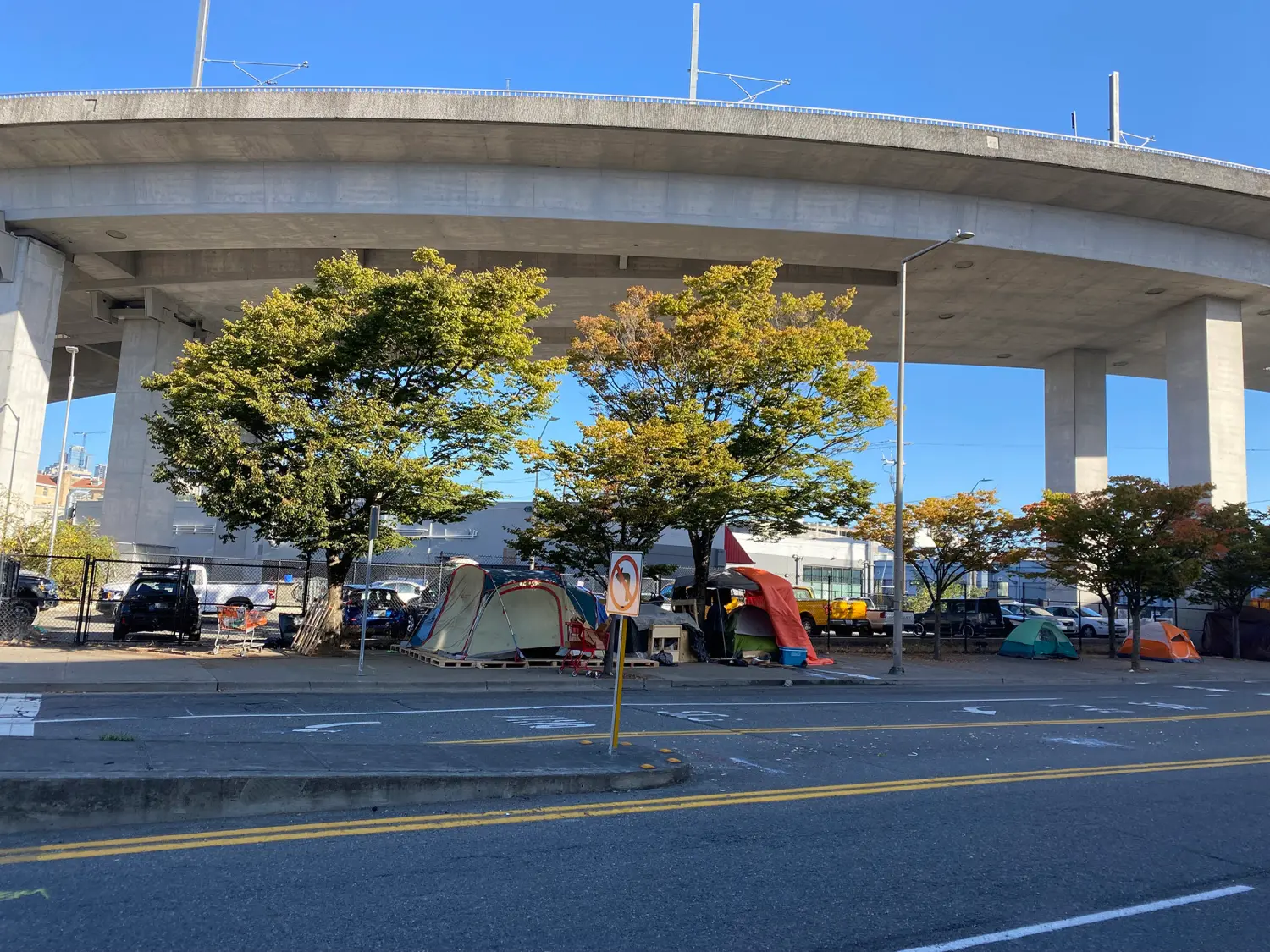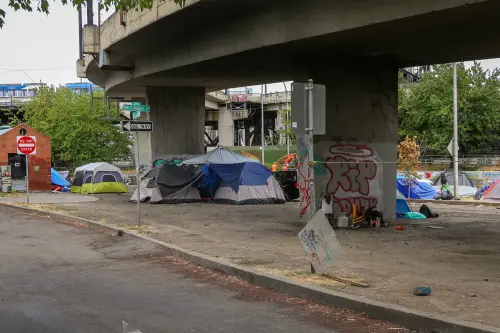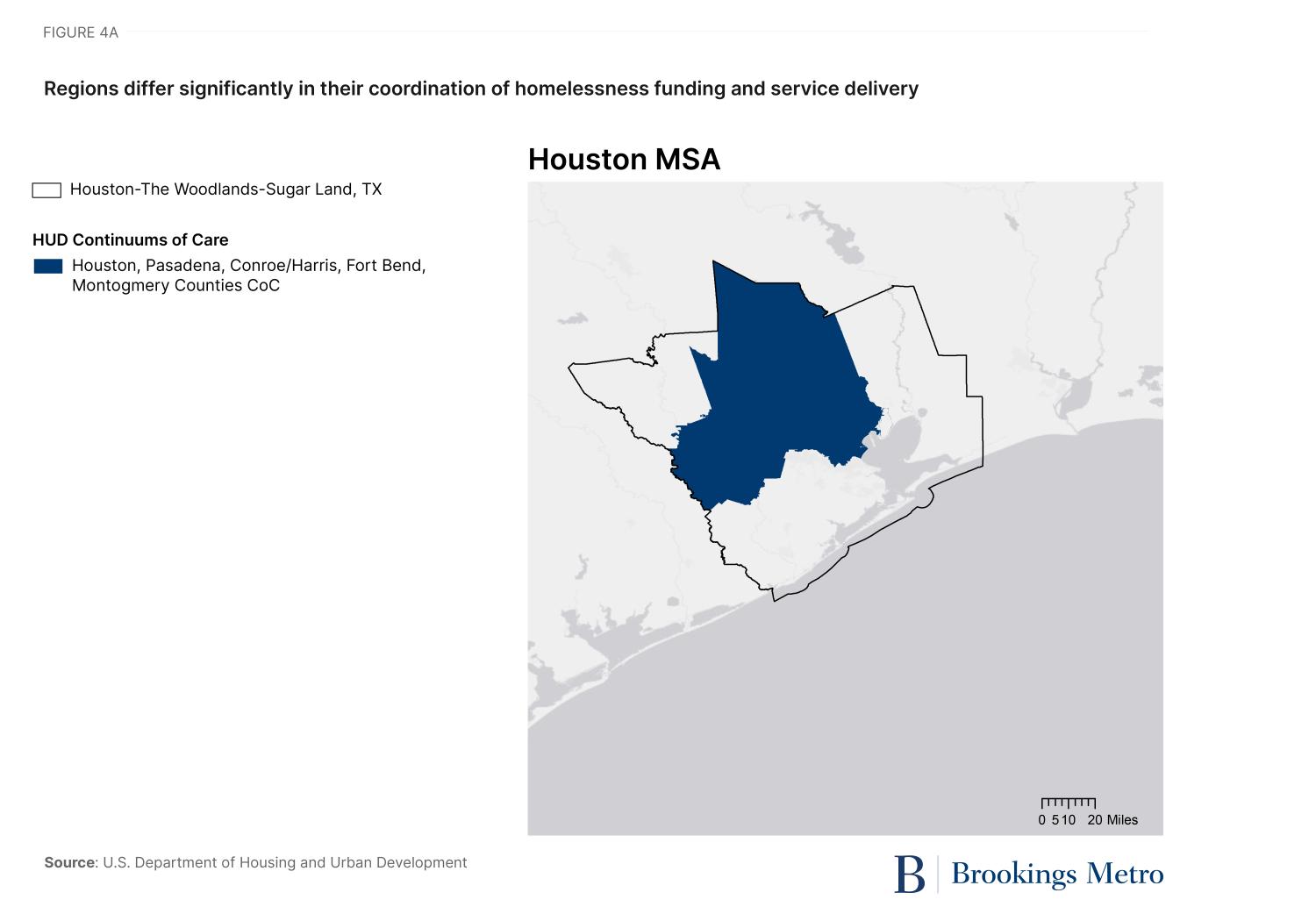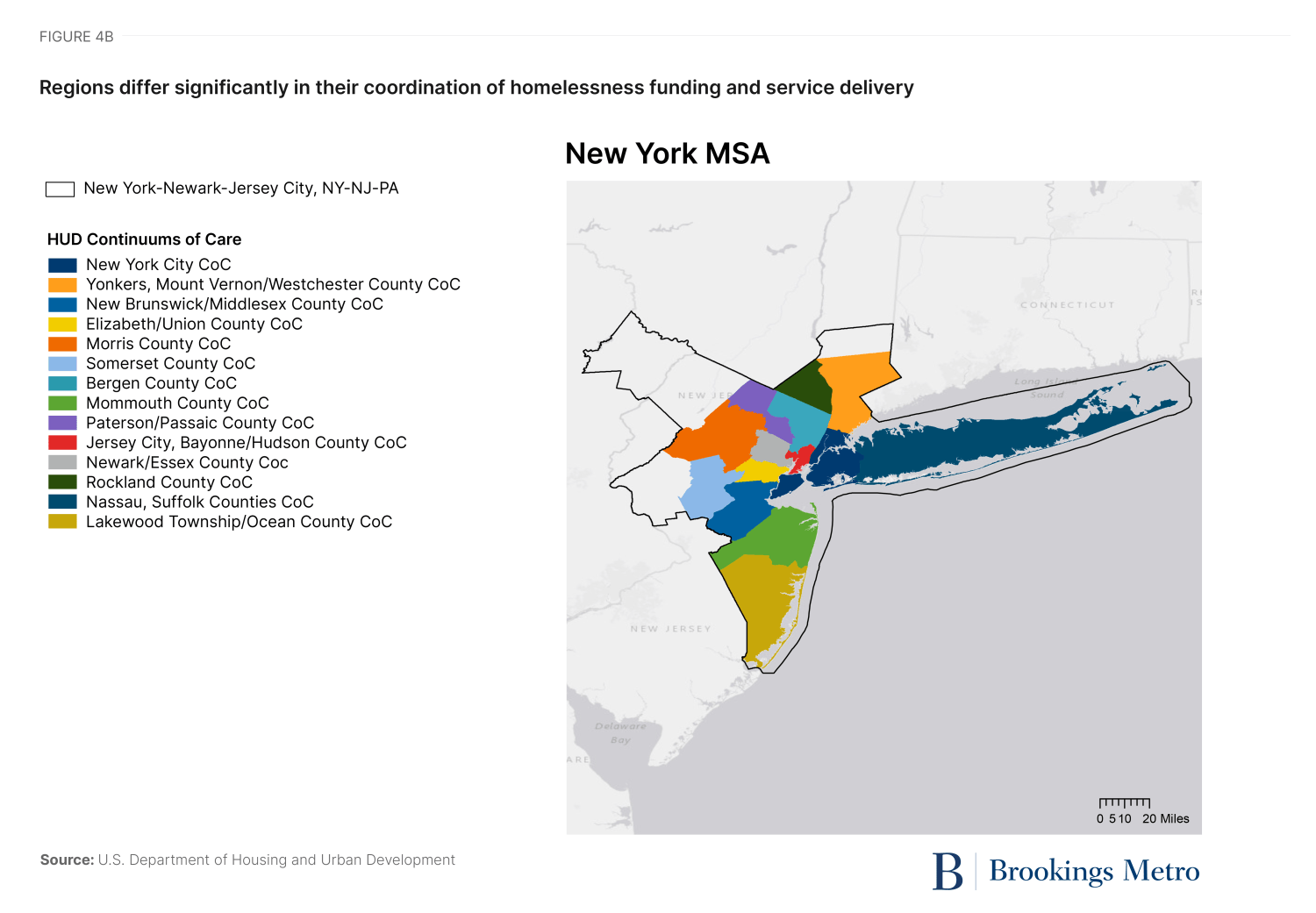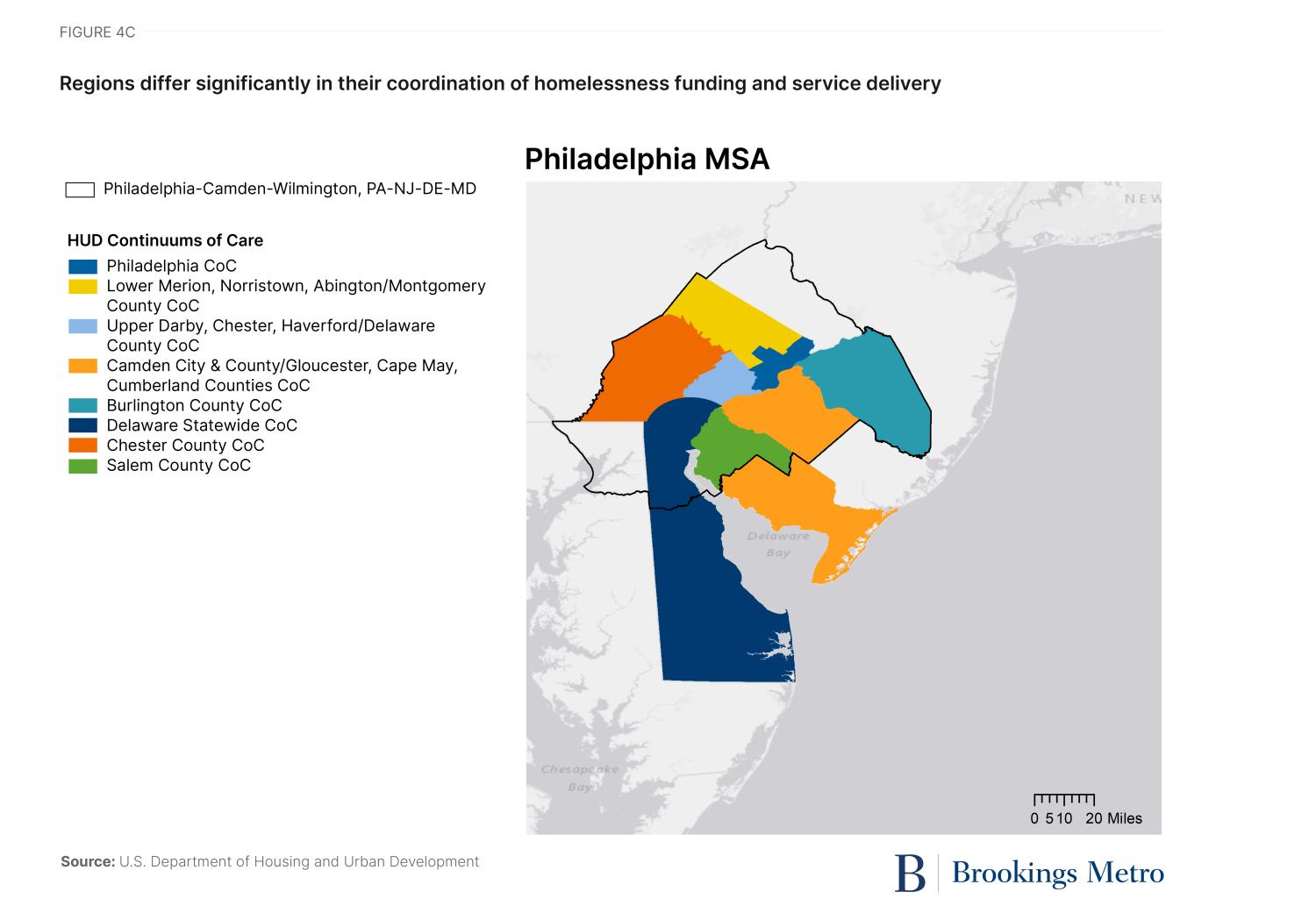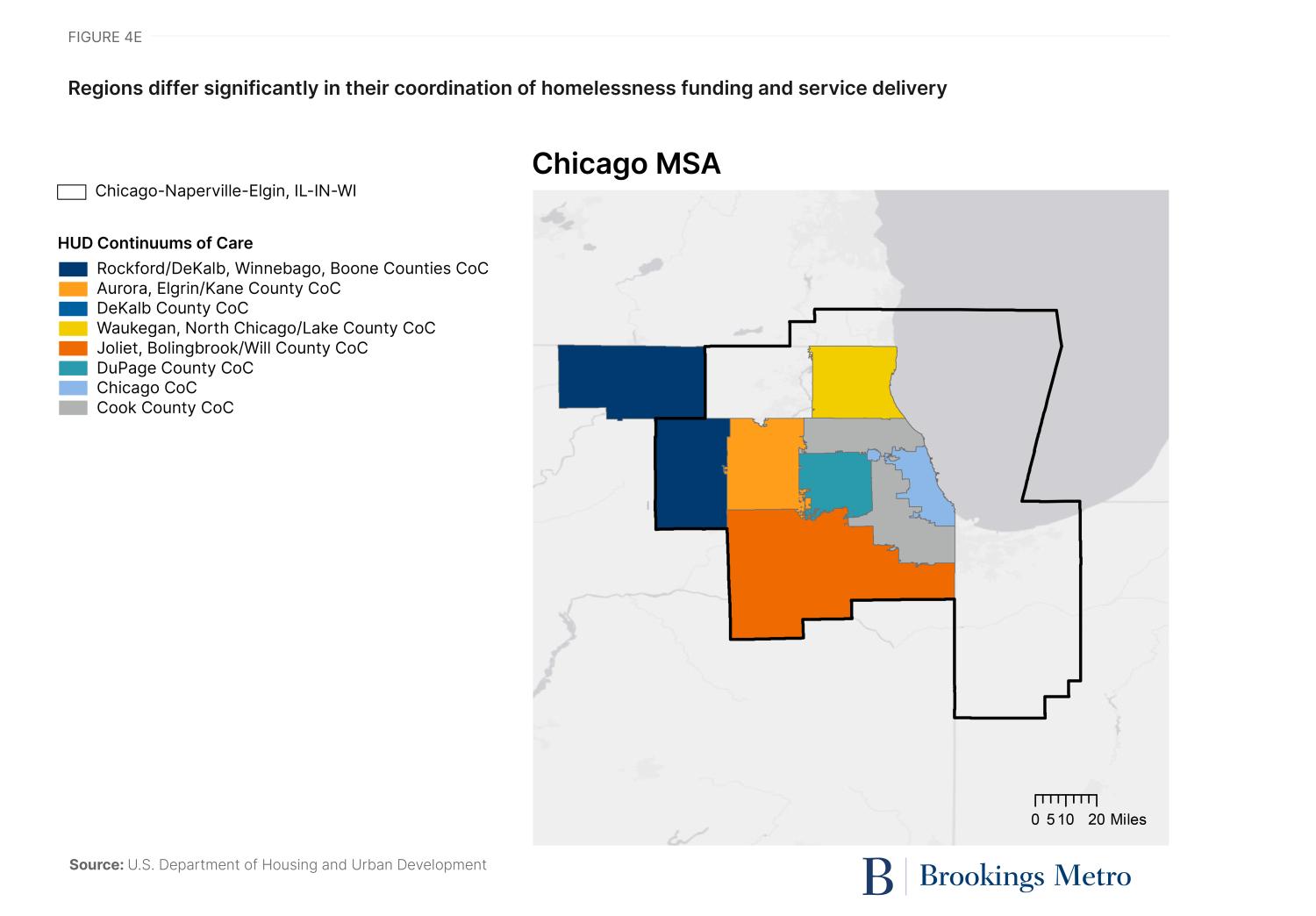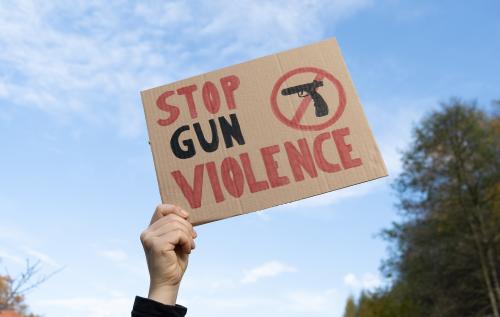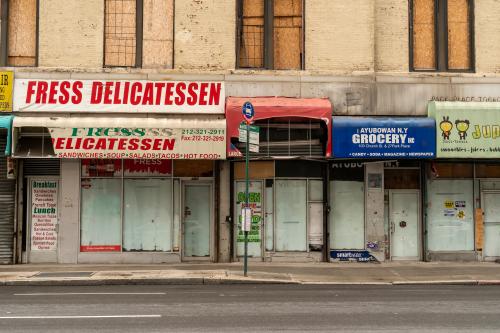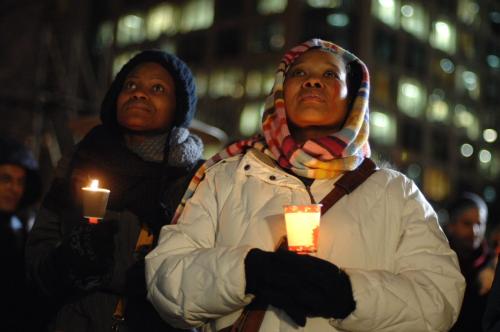A rare bipartisan consensus is emerging in many U.S. cities on one key issue: the need to address homelessness, particularly in downtown central business districts. Many on both the right and the left are calling for strategies such as encampment sweeps, increased enforcement of quality-of-life offenses, and even scaling back federal dollars for evidence-based “housing first” policies to quell rising fears of public disorder, homelessness, and crime in “hollowed out” downtowns.
The problem with this growing consensus is that it has led many local leaders further away from proven root-cause solutions for reducing homelessness, and toward costly and ineffective punitive measures that pose significant risks to people experiencing homelessness, and, paradoxically, increase the general risk of making homelessness worse.
Rather than responding to this latest reactive, “complaint-based” push that tends to over-criminalize people experiencing homelessness, we argue that local leaders must double down on evidence-based policies that address where, why, and how homelessness actually occurs within U.S. cities to meaningfully reduce homelessness and achieve economic recovery in the nation’s downtowns.
With these goals in mind—while also remaining responsive to constituents’ growing concerns about homelessness—this report presents an overview of recent pandemic-era trends in homelessness, compares perceptions of homelessness with data from four large cities, and reviews the evidence about cost-effective, humane, and root-cause approaches to reducing homelessness.
Taken together, our research supports the need for U.S. cities to engage in both short- and long-term policymaking targeted at the structural challenges associated with homelessness spanning, from reentry services to affordable housing, rather than crafting reactive homelessness policies rooted solely in perceptions, stereotypes, and fear. By doing so, local leaders can not only help cities and their downtowns recover from current economic disruptions, but they can also cultivate a sustainable regional ecosystem in which access to housing, economic stability, and opportunity is a human right.
Brookings Metro’s Future of Downtowns Project: This report is part of the Future of Downtowns mixed-methods research project that seeks to understand the future of American cities and their downtowns through interviews, spatial data analysis, and direct engagement with local leaders in New York, Chicago, Seattle, and Philadelphia. To gauge perceptions of cities’ downtown health and recovery, we interviewed nearly 100 business leaders, major employers, public sector officials, and residents in these four cities in fall 2022,1 then juxtaposed qualitative findings with spatial analysis of employment, transit and travel, real estate, crime, and homelessness data impacting downtown recovery. This report synthesizes findings related to homelessness.
Homelessness trends, types, and service delivery ecosystems vary considerably across US cities
Before diving into recent homelessness trends impacting U.S. cities and their downtowns, it is important to first distinguish between different types of homelessness that affect cities and regions, how the prevalence of homelessness varies considerably nationwide, and the vast differences in the local and regional ecosystems that coordinate homelessness services and funding (also known as “Continuums of Care”) across U.S. metro areas.
The different types of homelessness affecting US cities and regions
Most fundamentally, the tenure of a city’s homelessness population (e.g., whether people are unsheltered or in other temporary housing situations such as emergency or transitional shelters) can hold significant and often underappreciated ramifications for local policymaking. For instance, the most visible form of homelessness—when people are unsheltered and live in public spaces like parks, subway stations, or streets—represents only one-third or less of the unhoused population in most cities, despite capturing the bulk of resident and media attention, as well as significant city resources.
In New York and Philadelphia, for instance, most homeless people are not unsheltered, but rather reside in temporary shelter or transitional housing (94% and 82%, respectively) (Figure 1). In Chicago, most of the homeless population resides in either emergency shelter (46%) or transitional housing (20%), with 33% living unsheltered. Seattle is the stark outlier in the sample: Over 57% of its homeless population is living without shelter. These variations matter because a city like Seattle that is struggling with over half of its homeless population living unsheltered will require a different set of policies than a city like New York, whose “right to shelter” mandate has helped secure temporary shelter for most people experiencing homelessness.
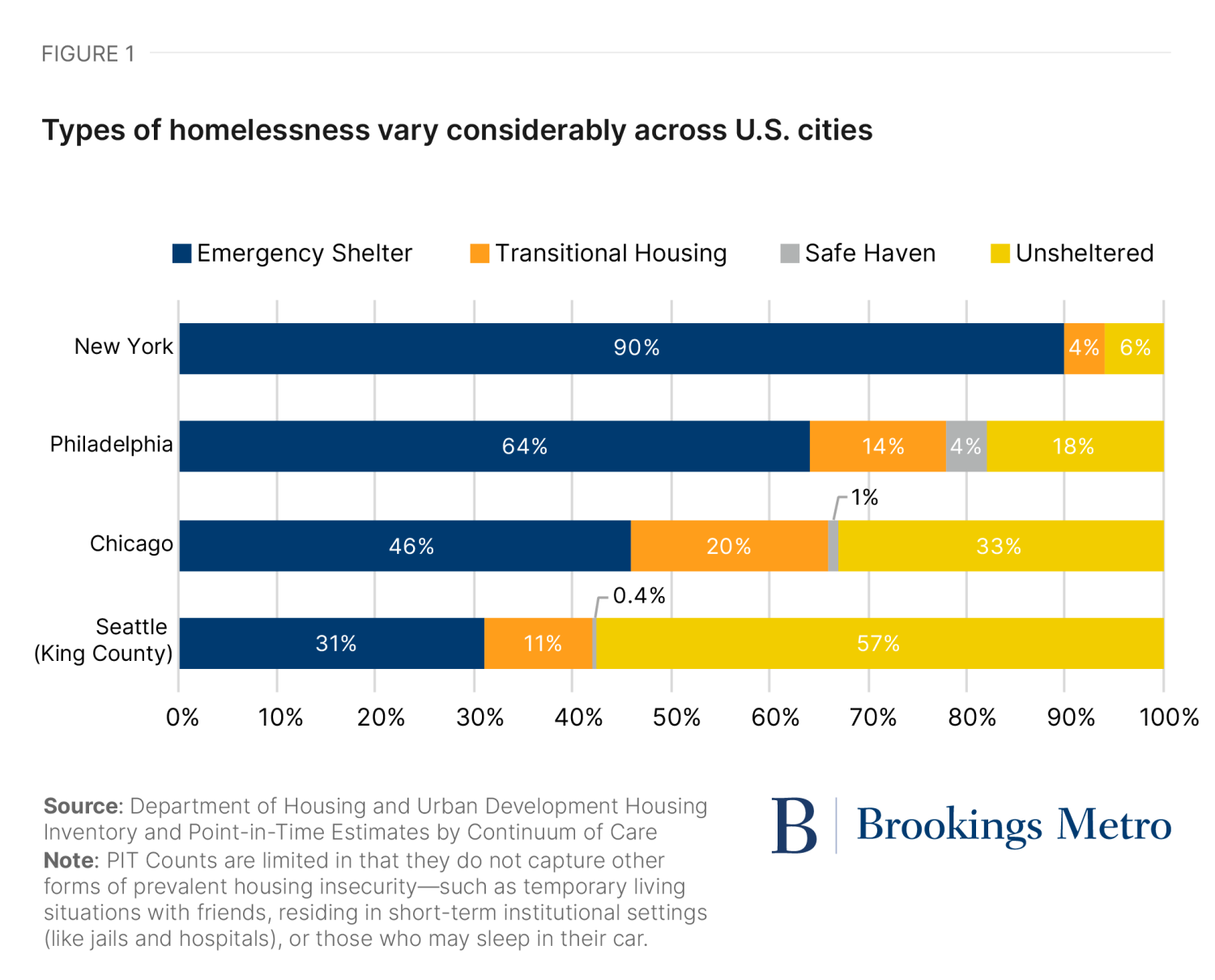
Variations in the prevalence of homelessness across the US cities and regions
Stark regional variations in the prevalence of homelessness across U.S. cities and regions also matter significantly for policymaking. As Table 1 demonstrates, cities on the West Coast have higher homelessness rates than other regions—representing seven of the 10 cities with the highest total homelessness rates per capita. San Francisco, for instance, has a total homelessness rate that is nearly 20 times higher than Houston’s. West Coast cities also stand out for higher shares of their homeless population living without shelter. In addition to Seattle, West Coast cities including San Francisco; Long Beach, Calif.; Los Angeles; Portland, Ore.; Oakland, Calif.; Sacramento, Calif.; San Jose, Calif.; and Fresno, Calif. all have unsheltered homelessness rates above 50%.
These findings generally align with research showing that above any other factor, regional housing market dynamics—particularly when rents rise by amounts that low-income residents cannot afford— drive geographic variations in the prevalence of homelessness across U.S. regions and correlate with higher homelessness rates (Figures 2 and 3). In Seattle, however, even pandemic-era reductions in asking rents were not enough to curb homelessness.
While these regional variations can make it difficult to adopt a “one-size-fits-all” approach to reducing homelessness in the U.S., they can provide insight into the local policies and socioeconomic conditions that work to facilitate homelessness reduction.
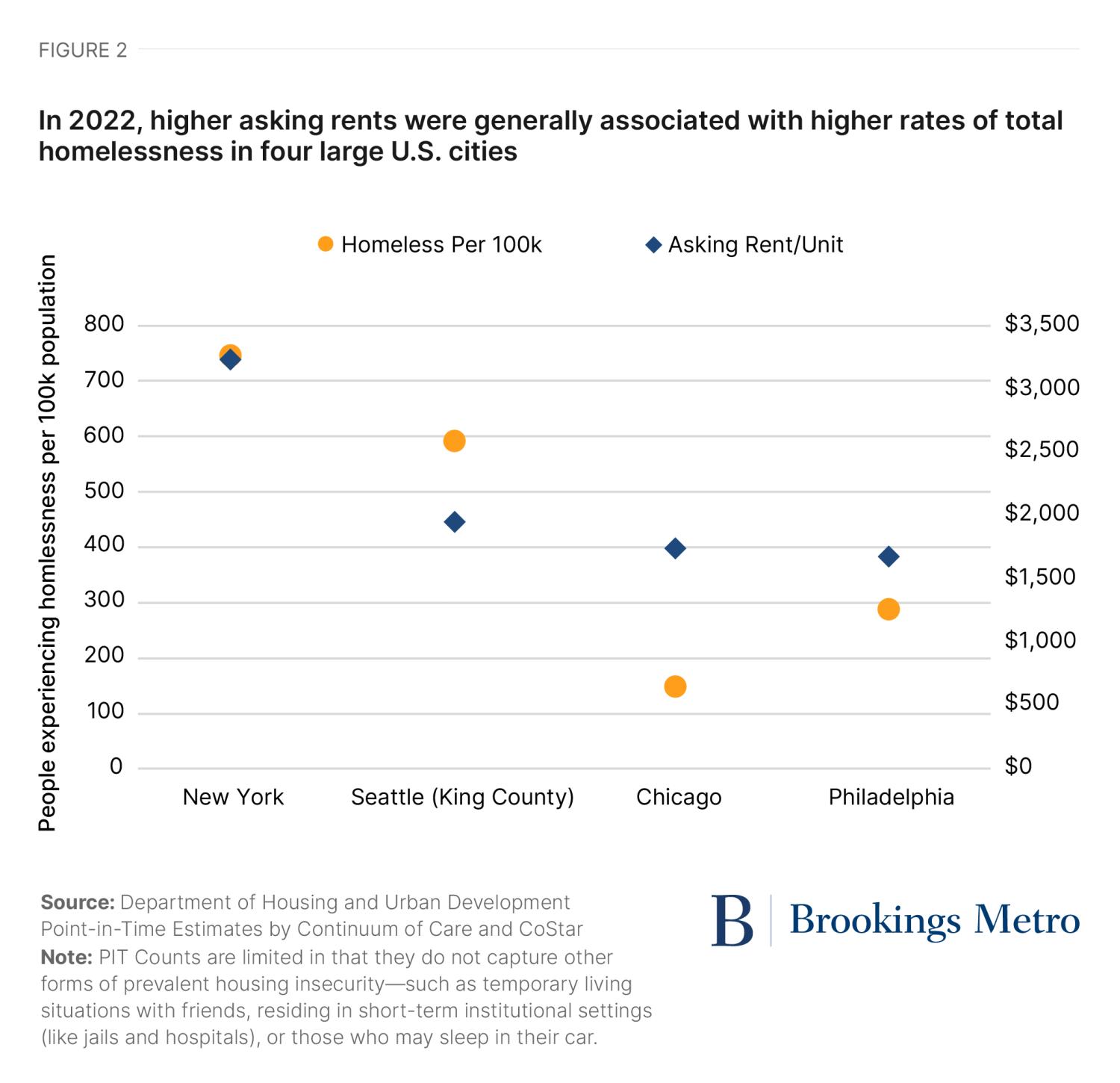
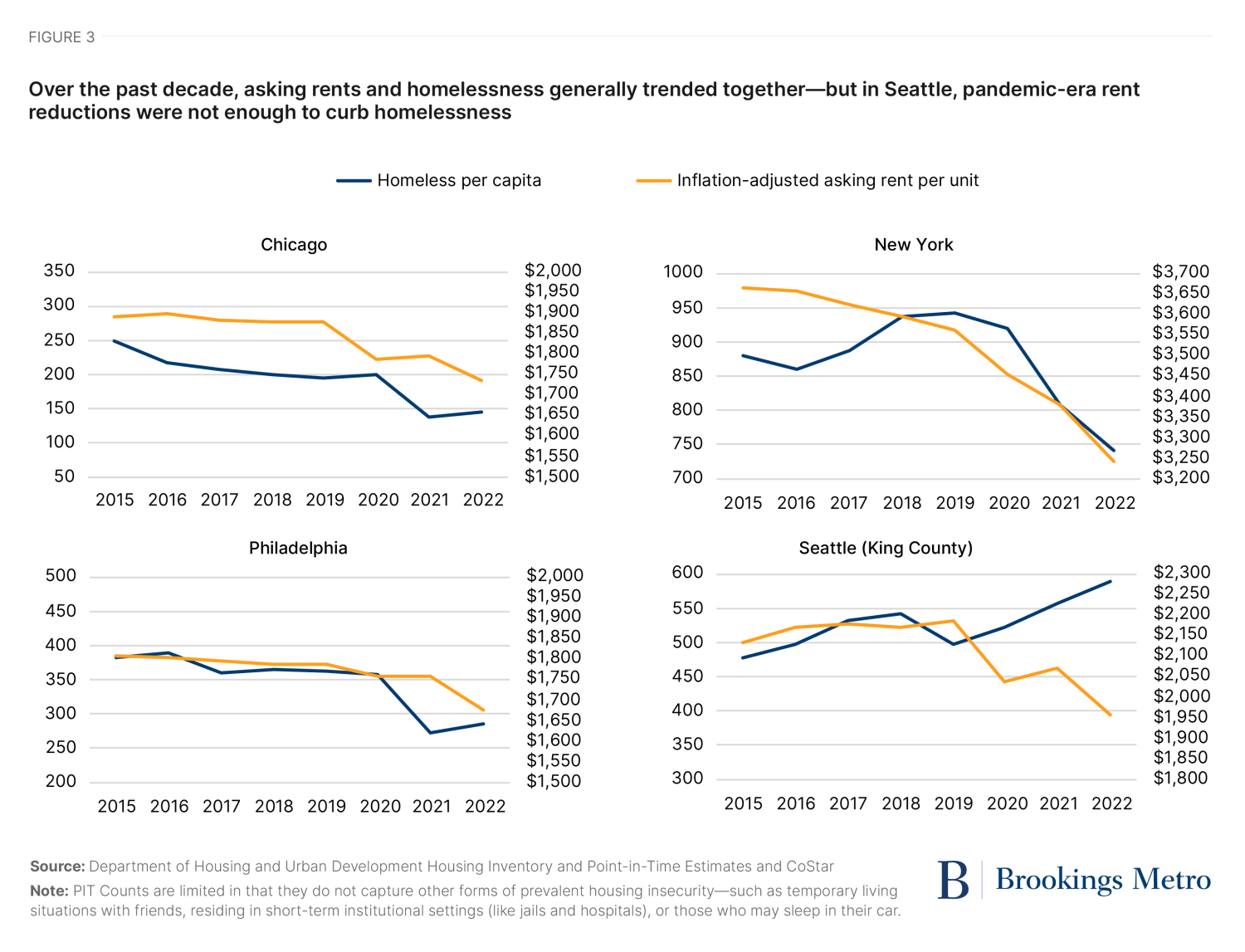
Different service delivery ecosystems for homelessness across US cities and regions
Finally, differences in regions’ Continuums of Care (CoCs) boundaries add another important layer to both understanding and solving the challenge. CoCs are the local or regional planning bodies that coordinate housing support, social services, funding, and reporting across service providers, hospitals, businesses, advocates, and government agencies (e.g., school districts, law enforcement, and public housing authorities).
As Figure 4 demonstrates, metropolitan areas such as Houston2 and Seattle take a “regional approach” to homelessness, in which funding and service delivery are consolidated across an integrated CoC area that includes both cities and suburbs to eliminate redundancies across agencies, fill gaps for underserved populations, and match resources with the scale of the challenge. On the other hand, metro areas such as Chicago and Philadelphia divide their homelessness services across a more fragmented and localized patchwork of providers, which limits the potential for regional collaboration. Understanding these nuances in the resources and ecosystems for homelessness prevention and reduction is critical for crafting effective policy.
Why focus on homelessness downtown, specifically? Downtowns play a critical role in local economies—serving as regional job hubs for both high- and low-wage work, supplying an outsized share of tax assessable value that maintains city budgets, and supporting clusters of small businesses that represent opportunity for entrepreneurs, artists, and creatives. People experiencing homelessness concentrate in downtowns for many of the same reasons that others do: a combination of highly accessible transit services, great density of public spaces and other amenities, and the concentration of critical public-serving institutions. In many cities, downtowns represent the most visible hub for people experiencing homelessness to gather, and this uneven spatial distribution often places pressure on a small number of downtown leaders to “solve” homelessness—even when its causes are rooted in structural challenges that extend far beyond downtown boundaries.
Comparing perceptions and realities of homelessness trends in New York, Philadelphia, Chicago, and Seattle
When conducting qualitative interviews for the Future of Downtowns project in fall 2022, we asked nearly 100 residents, workers, visitors, and employers in four of the largest U.S. cities about the top barriers preventing them from returning downtown—spanning issues from the changing nature of office work to different preferences for commuting and in-person interaction. To our surprise, we heard remarkably consistent results across the four cities: Interviewees told us that increased fear of public disorder, crime, and homelessness in the wake of the pandemic was the primary barrier preventing them from returning downtown—not changing office or residential patterns. This section compares these perceptions with quantitative analysis of pandemic-era homelessness trends in each city.
Respondents across all four cities perceived significant increases in homelessness since the pandemic, often describing “new negotiations” in public spaces with unhoused people and rates of public disorder not seen since the late 20th century. They frequently made statements such as:
Homelessness wasn't even like this during the crack cocaine 80s. It is terrible.
Interview Respondent in Philadelphia
There are more homeless people in more places now than there were pre-pandemic. I would say that's true of every city I've been in.
Interview Respondent in Chicago
The top thing we hear from employers is about the experience on the street with safety and chronic homelessness.
Interview Respondent in Seattle
In the pandemic, my neighborhood changed meaningfully in terms of the crime rate and just the level of homelessness
Interview Respondent in New York
Yet when we crunched the numbers to determine how perceptions of rising homelessness during the pandemic bore out in data, we found a significant mismatch between perception and reality in three of the four study cities. Interview respondents in Chicago, Philadelphia, and New York perceived that homelessness was increasing exponentially and leading to a level of public disorder not seen since the 1990s. However, total homelessness rates in these cities actually significantly declined in the past decade (by 42%, 25%, and 16%, respectively). And it continued this decline during the pandemic (Figure 5). Seattle remained the stark outlier, with total homelessness increasing by 23% since 2015.
In New York, Chicago, and Philadelphia, we found a similar pattern with trends of unsheltered homelessness. They had not “ballooned” during the pandemic, as most interviewees supposed, but rather remained steady for the past decade and declined between 2020 and 2021 (Figure 6). Seattle, again, was a stark outlier—seeing an 88% jump in unsheltered homelessness since 2015, which continued during the pandemic.
Our findings from Chicago, Philadelphia, and New York generally align with recent research from the U.S. Department of Housing and Urban Development, which found that the nation was able to hold off a spike in homelessness during the pandemic due to federal relief authorized between 2020 and 2021, including eviction moratorium orders, emergency rental assistance, boosted unemployment benefits, and the expanded child tax credit. Seattle, however, demonstrates that even these vital federal supports were not always sufficient to reverse a decade-long spike in homelessness. The gap between perception and reality may in part be explained by significant changes in downtown foot traffic, which made unsheltered homelessness more visible given the relative reduction in other foot traffic.
Why fluctuations in homelessness—such as recent increases in unsheltered asylum seekers in cities like New York—can be difficult to capture: Because most CoCs conduct and report “point-in-time” counts annually or every other year, it can be difficult to measure temporary or seasonal changes in cities’ homelessness rates. Recently, this has presented a challenge in understanding the impact of new waves of migrants and asylum seekers arriving from Latin America on homelessness in cities such as Chicago, New York, and Washington, D.C.3 For these data availability reasons and other more substantive ones—including the unique circumstances surrounding recent migration and its toll on a limited set of large U.S. cities—this report does not seek to respond to the intersection between homelessness and asylum seekers’ migration. Instead, we focus on the long-standing structural drivers of and evidence-based tools to address the persistent challenge of homelessness that cities have been wrestling with, even absent acute changes in global migration and asylum policies.
In addition to the fact that respondents perceived significant increases in homelessness during the pandemic, they also overwhelmingly conveyed a strong sense that homelessness was linked to criminality. Rather than discussing the challenge as one rooted in larger economic and regional market forces, respondents tended to focus on the behaviors of individual homeless people that made them uncomfortable (such as sleeping outside or public drug use), and thus were drawn toward interventions directed at individual behavior through the criminal legal system.
In fact, respondents often described crime and homelessness in the same breath, with statements such as:
There’s just lawlessness in the public realm. There’s garbage, there's a guy smoking pot, there's a homeless person I just stepped over, there's somebody who's crazy following me, there are vendors everywhere.
Interview Respondent in New York
The homeless population has ballooned here, which makes people feel uneasy and unsafe. Crime has always existed in Chicago, but this is different.
Interview Respondent in Chicago
There is a fair amount of violent crime that kind of emanates from those encampments. We see a lot more people unsheltered, a lot more drug use, a lot more organized retail theft.
Interview Respondent in Seattle
There's a lady over there…She sits there all day. We tell her you can't sleep on a bench. She just sits on the bench. That's criminal.
Interview Respondent in Philadelphia
It is notoriously difficult to determine whether a criminal offense involves a person experiencing homelessness (either as a victim or perpetrator), since most police departments do not track or report that data. However, research does suggest that the criminalization of homelessness is costly and counterproductive, as arrests make it more difficult for homeless people to get back on their feet and access housing due to the heightened barriers navigating employment, services, and housing with a criminal record.
Taken together, our analysis and existing evidence indicate that perceptions alone are insufficient to inform local decisionmaking on homelessness, and that a clear understanding of data, regional market variations, and local service delivery ecosystems is necessary to craft effective policy. The next section presents five recommendations to better align data and evidence and reduce homelessness through root-cause approaches.
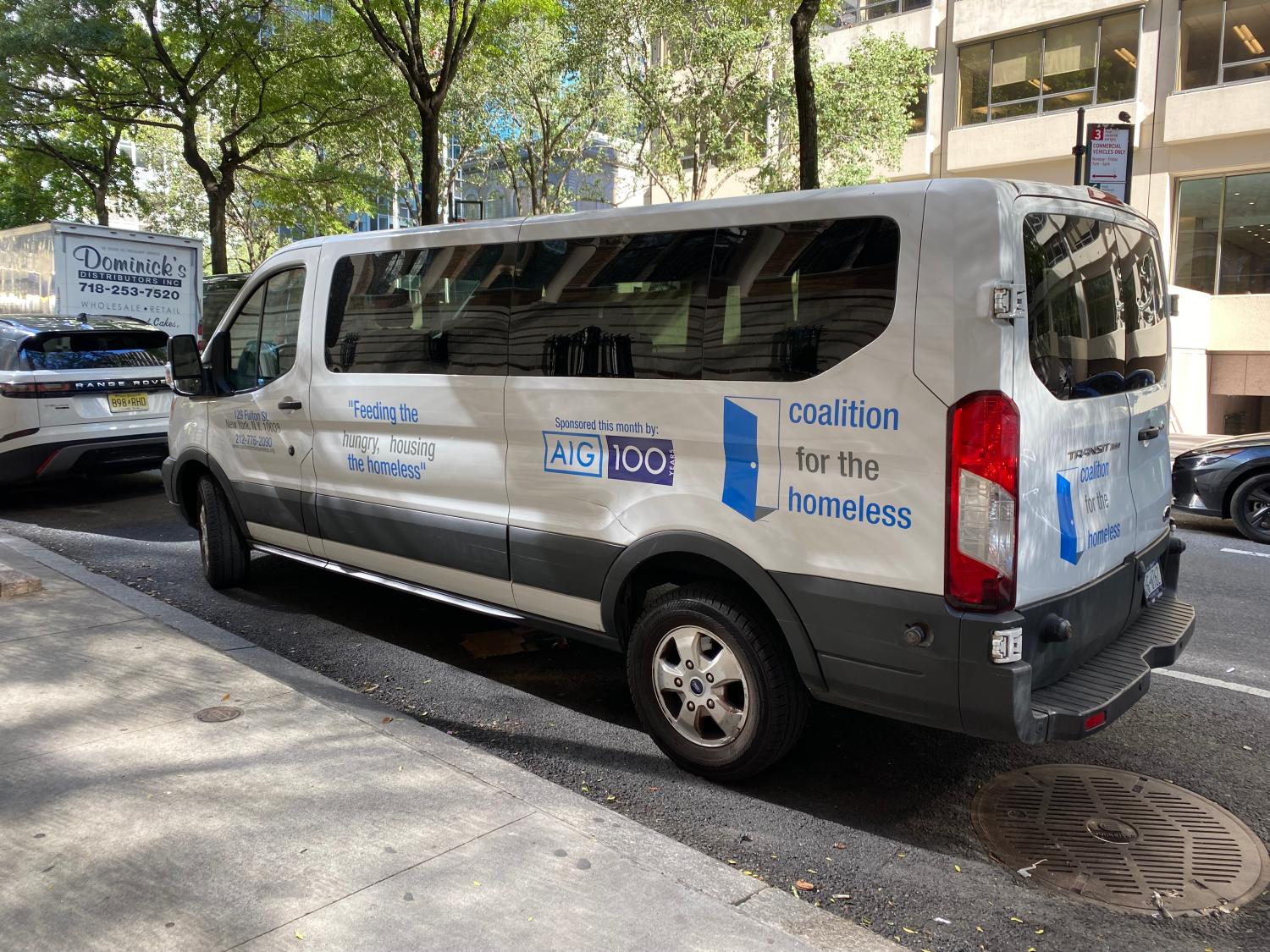
An evidence-based policy framework for reducing homelessness and strengthening regional economies
The ability to spend time downtown without encountering public disorder such as visible drug use or harassment is a basic necessity of city life—as is the desire to have a safe place to sleep, bathe, and eat. Fortunately, there are evidence-based policies that can bring cities closer to this dual imperative in a humane, cost-effective, and sustainable manner. We offer five key recommendations below:
-
Ensure that housing policy is homelessness policy
Inadequate housing supply, particularly of affordable units, is consistently shown to be the primary driver of homelessness in the U.S.—significantly outweighing factors such as substance use, poverty, and mental health. Zoning and land use restrictions are examples of local governments’ dysfunctional fiscal and regulatory structures that disincentivize or prevent housing production and contribute to a widespread structural challenge in which the poorest people within cities cannot afford average asking rents for available apartments. Despite this evidence, a study from Community Solutions found that of the nation’s 100 largest cities, only 54% had homelessness plans, and of those, only 30% mentioned zoning and land use changes.
To craft policy that addresses the root causes of homelessness, we recommend that local governments align their long-term housing, land use, and homelessness plans to increase the supply of all types of housing, remove barriers to affordability and shelter construction (such as single-family-only zoning, parking minimums, and parcel shape regulations), and adopt evidence-based “housing first” models. For shorter-term solutions, cities should adopt and scale the pandemic-era preventative measures that helped avoid a spike in homelessness, including investments in emergency rental assistance, eviction defense, tenants’ rights, and economic stimulus, as well as mitigation measures such as converting hotels into temporary housing. For cities such as Seattle, where shelter bed capacity is incredibly overburdened (Figure 7), the need for these measures is particularly acute.
Case study from New York: How ‘housing first’ programs can be a proven, humane, and cost-effective strategy for reducing homelessness
New York’s Housing First program has been in place for over three decades to provide housing supports for people experiencing chronic street homelessness without preconditions—a recognition that stable housing is a critical foundation for individuals struggling with psychiatric and substance use disorders to transition from homelessness. The program has a 70% to 90% success rate in maintaining stable housing for participants over two to three years, outperforming traditional housing programs. Additionally, it has proven to be a cost-effective strategy (Table 2) that reduces public expenditures in the criminal justice and health care systems associated with homelessness.
The Housing First program’s effectiveness can be seen in its Frequent Users Service Enhancement (FUSE) initiative, which has been successful in breaking the homelessness-to-jail cycle. FUSE provides long-term rental assistance and supportive services, resulting in 86% of participants remaining stably housed after two years and a 40% reduction in jail time, while also achieving significant cost savings in annual jail, shelter, and crisis health care costs.
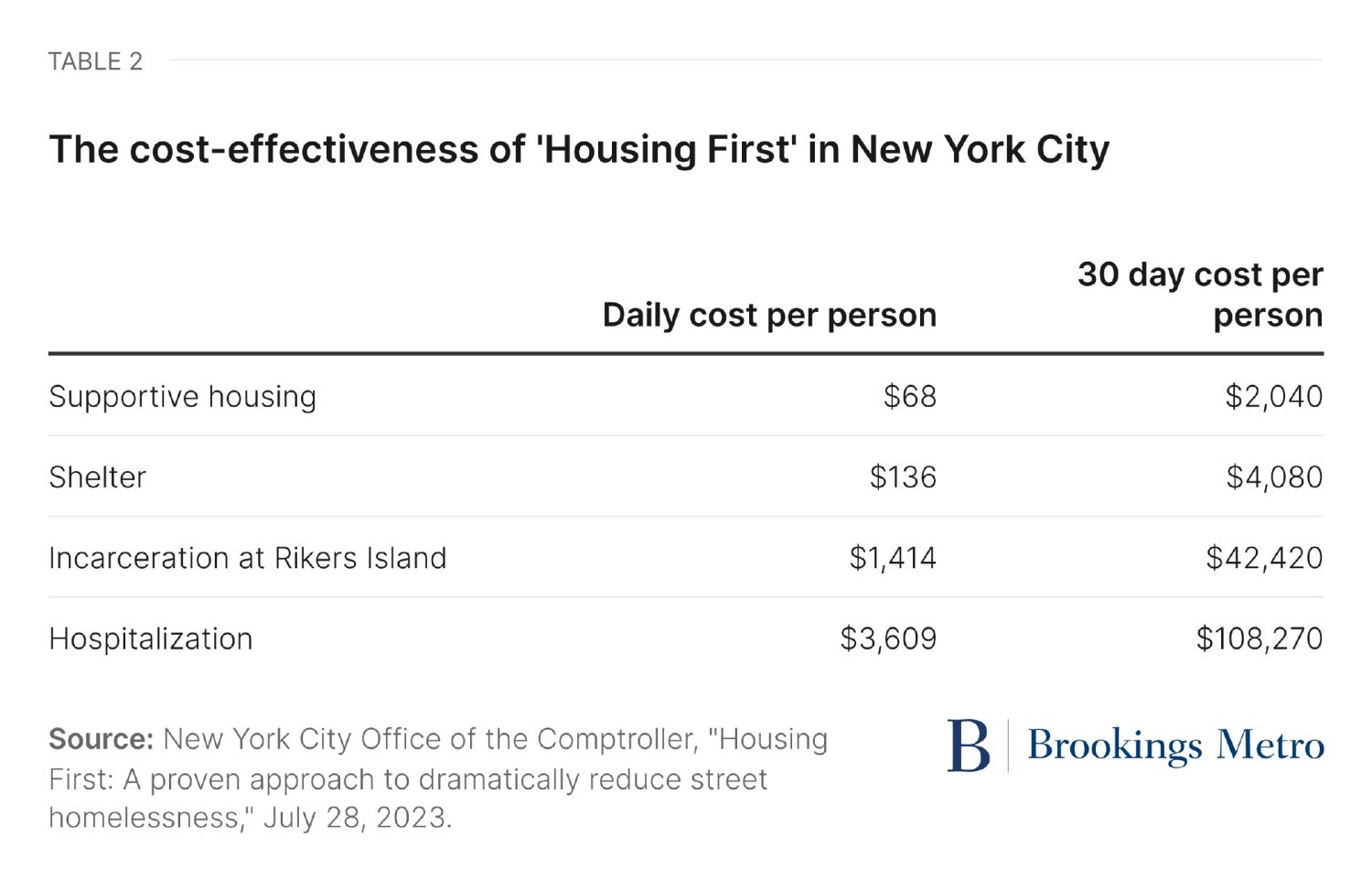
-
Scale alternative crisis response models to better respond to people with behavioral health and substance use emergencies while improving public safety
Research indicates that punitive approaches to policing homelessness—such as criminal arrests or fees for public behaviors associated with homelessness (e.g., camping, sleeping in public, eating in public, sitting on sidewalks, etc.) or mental health episodes—make it more difficult to solve homelessness. These approaches heap a criminal record onto people experiencing homelessness, making it difficult for them to rent an apartment or get a job on top of other challenges, while also straining police resources.
Instead, an emergent and promising body of research demonstrates that non-police crisis responders—alternatives to 911 with trained mental health professionals—can better respond to lesser infractions involving homeless people. In places such as Denver, non-police crisis responders were more effective than even alternative crisis response models that deploy both social workers and the police together (sometimes referred to as “co-responder models”). Moreover, supportive housing programs such as those mentioned above have successfully reduced arrests and jail stays for people experiencing homelessness; for example, New York’s FUSE initiative lead to an average of 95 fewer days spent in jail for homeless New Yorkers.
Despite this evidence, a Community Solutions survey of mayors found that homelessness policy is intertwined with police enforcement in most cities. For instance, 78% of survey respondents said that police have influence over shaping homelessness policy in their city, 59% said police enforce quality-of-life charges against homelessness people, and 22% had their homelessness staff co-located in police departments. This has led to a phenomenon in which jurisdictions are using jails as substitute shelters. For example, in Atlanta, one in eight of all city jail bookings in 2022 involved a person experiencing homelessness.
To better address safety concerns surrounding homelessness, mental health, and quality-of-life offenses, local leaders should act on evidence from Denver, Eugene, Ore., and other cities to adopt and scale non-police alternative crisis response models. In doing so, they should take care to not only prioritize crisis response models that provide an alternative for low-level offenses (such as substance use or homelessness), but also include models that address intimate partner violence—another area where victims are disproportionately likely to experience homelessness as a result of the circumstances surrounding victimization.
Case study from Denver: How ‘alternative response models’ can reduce the homelessness-to-jail pipeline
In June 2020, Denver launched its Support Team Assisted Response (STAR) program to redirect nonviolent 911 emergency calls from police to a team of mental health specialists and paramedics. Inspired by the evidence-based CAHOOTS model in Eugene, Ore., the STAR program focuses on providing appropriate care and resources to individuals facing mental health crises, substance use issues, or homelessness—particularly in low-income and at-risk communities. Funded through the city’s general fund and a grant from the Caring for Denver Foundation, the STAR program aims to alleviate the burden on police resources, ensuring law enforcement can concentrate on more serious crimes.
The model has been found to produce effective results, with a 34% reduction in lower-level crimes in areas served by STAR, leading to 1,400 fewer criminal offenses. Furthermore, the direct costs associated with the STAR responses were found to be four times lower than those incurred with police-only responses, with the average direct cost per response being $151—significantly less than the $646 typically incurred for minor criminal offenses handled by the police.
-
Strengthen housing and employment supports for those reentering from incarceration
It is well established that homelessness and incarceration are inextricably linked in the U.S., with many people cycling between jails and prisons and homelessness on the front end (due to the criminalization of low-level “survival” crimes) and on the back end (due to the lack of support for returning citizens to access employment and housing because of the significant barriers that criminal records pose). But often, less attention is paid to preventing those being released from jail or prison from entering into homelessness.
In New York, for instance, over half of people released from prison move directly into the shelter system. In California, which does not require returning citizens to have a place to live upon release, many move directly into street homelessness. Nationwide, formerly incarcerated people are nearly 10 times more likely to experience homelessness than the general population.
To better address the pipeline between incarceration and homelessness, study after study shows that bolstering reentry supports—particularly access to housing and employment—is critical to reducing recidivism and homelessness, while also improving public safety. Effective policies include reducing barriers for returning citizens to enter public housing, providing tailored services for those most at risk for homelessness prior to release (including workforce and housing supports), and explicitly addressing the unique needs of returning citizens in regional housing and homelessness plans, among other reforms.
Case study: How Cuyahoga County and Houston are curbing the prison-to-homelessness-pipeline through new supports for returning citizens
In response to growing evidence indicating the need to reduce the prison-to-homelessness pipeline, in 2023, Cuyahoga County, Ohio (where Cleveland is located) launched a $37-million Housing Justice Plan that seeks to develop 105 housing units available to individuals with criminal backgrounds, provide short-term funding to subsidize housing costs for those leaving prison, and pilot a program to provide down-payment assistance or lease-to-own opportunities. For those in jail, Houston is operating a Healthcare for the Homeless jail in-reach program that provides intensive medical case management to incarcerated people, as well as counseling, psychiatry, substance use treatment, dental care, housing, employment, help with navigating public health benefits, and help obtaining identification.
-
Leverage the capacity of place governance organizations to humanely address homelessness, particularly in central business districts
While public sector officials hold the bulk of the power to address the structural causes of homelessness, downtown place governance organizations (such as business improvement districts and other special-purpose districts) also play an outsized role.4 The International Downtown Association estimates that there are over 2,500 place management organizations in North America with the capacity to leverage millions of dollars in special tax assessments. Many of these organizations have high exposure to challenges associated with homelessness.
Special districts such as business improvement districts (BIDs) have at times been complicit in the act of displacing homeless people and embracing hostile architecture. However, they have also been pragmatic, effective leaders in innovating and implementing inclusive management practices aligned with a public health approach by employing community ambassadors; providing access to drinking water and public restrooms; supporting placemaking activities and other built environment improvements that enhance safety, vibrancy, and belonging in the public realm; and connecting residents to social services, employers, and workforce development providers.
Case study from Philadelphia: How place-based partnerships and place governance organizations can support and bolster city services for homelessness reduction and care
Most emergency shelters in Philadelphia are closed during the day, meaning that the homeless population transitions from being sheltered to unsheltered and back again on a daily basis. In 2011, Project HOME, a nonprofit homelessness service provider in Philadelphia, sought to tackle this challenge by creating a drop-in day center for homeless people close to transit and City Hall.
Through place-based, cross-sector partnerships with city government and the regional transit authority, Project HOME was able to open the day center, Hub of Hope, for people to access food, health care, social services, laundry, showers, and fresh coffee provided by Wawa. It is the only drop-in center on transit property in the U.S. and currently serves approximately 200 people per day.
As part of its cross-sectoral approach, Project HOME also collaborates with Center City District (Philadelphia’s downtown place governance organization) and other private and public sector partners on a street outreach effort, the Ambassadors of Hope, which fields interdisciplinary outreach teams on the streets of Center City Philadelphia to engage chronically homeless people and connect them to help customized to their needs. Since 2018, over 700 people experiencing homelessness have received services and transportation off the street.
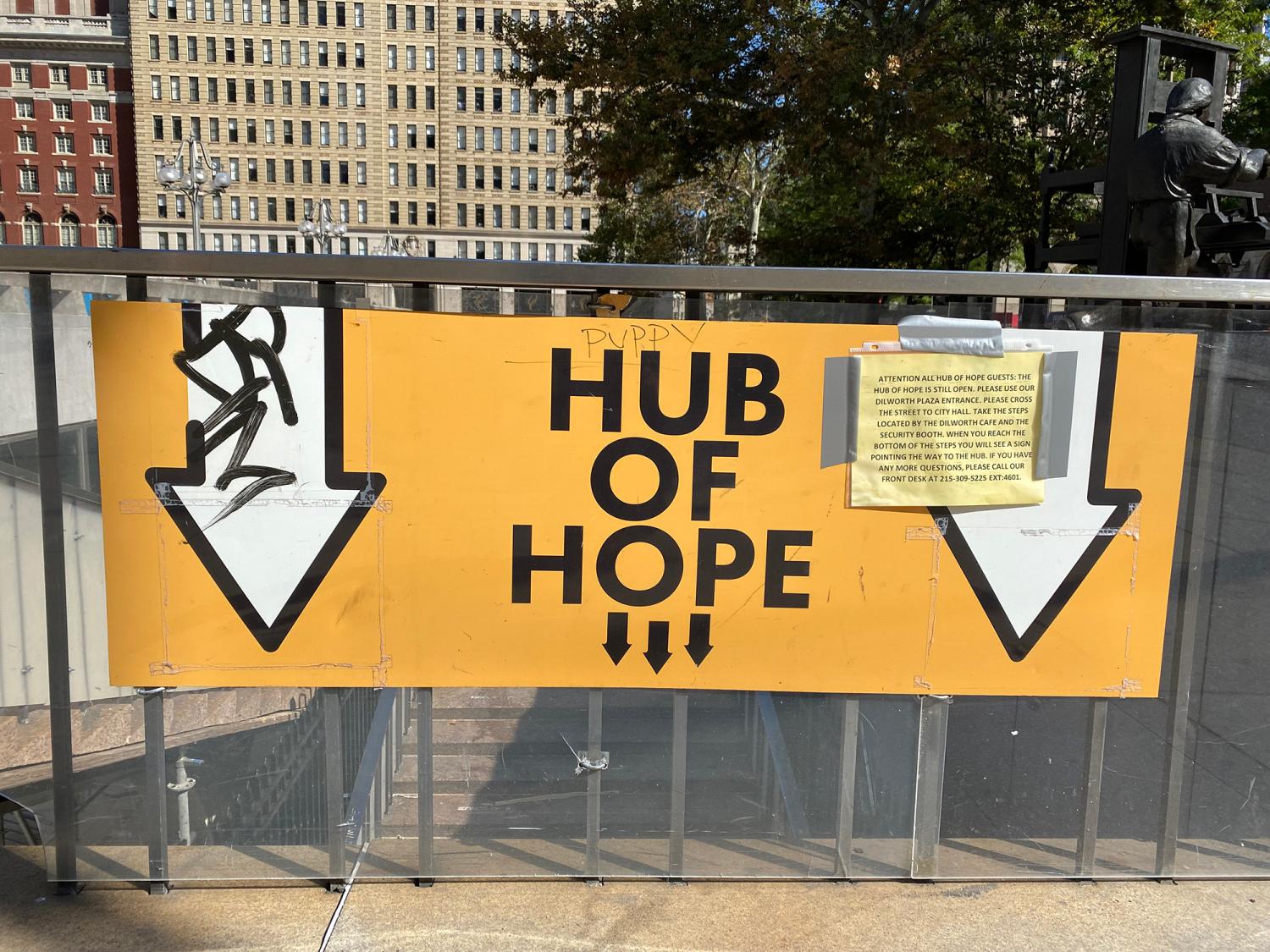
Philadelphia, Penn. / Authors’ original photo
-
Take a regional, data-driven approach to homelessness
There is growing consensus among homelessness service providers and city and regional officials that no one institution, organization, funding source, or level of government can solve homelessness alone. To respond to the structural challenges that prevent people across a region—not just within city boundaries—from accessing affordable housing, there is a movement to establish regional homelessness authorities that correspond to merged, regional Continuums of Care and align resources and service delivery programs across a region.
Cities and counties from the East Bay area to Spokane, Wash. to Houston have adopted a “regional approach” to homelessness to coordinate on cross-jurisdictional challenges to addressing homelessness by aligning regional funding, communications, coordination, social delivery infrastructure, data collection, performance management, and training and capacity-building. This helps regions understand the extent of homelessness in their region and transparently report performance metrics, which are critical to assembling the collective will and funding necessary to end it.
Case study: How cities and counties are working together on a regional approach to homelessness
Since 1994, the Metro Denver Homeless Initiative has coordinated data and services regionally—an early national leader on the regional approach that includes building, maintaining, and using a single “Coordinated Entry System” with real-time rather than annual data. Similarly, service providers, governments, philanthropy, and more came together in the Houston metro area in 2011 to form the Way Home—another regional approach that has successfully implemented the “housing first” model. Recently, the King County Regional Homelessness Authority (KCRHA) was established in December 2019 through an inter-local agreement between King County and the city of Seattle—representing a consolidated and regional approach to tackle a critical homelessness challenge that has spiked in the last decade. Even in places with less jurisdictional fragmentation, Continuum of Care participants can come together in more collaborative ways to create a regional approach. For example, in 2015, Strategies to End Homelessness was named the “Unified Funding Agency” for the Cincinnati/Hamilton County CoC.
These leading and innovative regional approaches have more in common than just high levels of cooperation, data, and streamlined funding. These initiatives seek to address a spectrum of socioeconomic challenges associated with homelessness, including through homelessness prevention, particularly focusing on communities of color such as Black and American Indian/Alaska Native populations, which are disproportionately affected.
Their work is characterized by clear planning and performance metrics, such as the KCRHA inter-local agreement that provides a community-driven, racially equitable, and data-informed methodology and operates in alignment with the Regional Action Framework, which outlines clear visions, policies, strategies, and success metrics while striving to balance immediate actions with long-term solutions. Many emphasize the importance of input from individuals with lived experience of homelessness. These metro areas have shown that a “regional approach” requires system integration, coordinated service delivery, and performance management.
Conclusion
Public, private, and civic sector leaders have the evidence at their disposal to advance pragmatic solutions that can not only reduce visible homelessness in downtowns, but also chart a future in which all residents of a region have access to more effective and humane service delivery ecosystems for housing, employment, and reintegration. This holistic, place-based approach to homelessness creates a foundation for a strong labor market and vibrant regional economy. Understanding the why, where, and how of homelessness across and within regions is critical to not only respond effectively to the needs of people experiencing homelessness today, but also to prevent people from experiencing homelessness in the future.
While the state of homelessness in a city like Philadelphia is not the same as in Seattle, the recommendations provided within this report—from increasing the supply of all types of housing to strengthening organizations that provide holistic, place-based support to bolstering reentry services for returning citizens—provide a roadmap based on evidence and root-cause approaches that a jurisdiction of any size can adopt and scale, with the right support and resources, to come closer to the goal of solving homelessness. This will require sustained commitment and coordination from local, regional, state, and federal leaders. Initiatives such as the Biden-Harris administration’s “ALL INside”—which is accelerating local efforts to reduce homelessness in Los Angeles, Dallas, Phoenix, and several other cities—are promising examples of how federal funds can be leveraged to escalate the response.
A large, unsheltered homeless population is not an inevitable part of human or urban life, and there is real harm and risk involved when solutions are not implemented early or are underfunded: both the harm to individuals experiencing the profound traumas of homelessness and incarceration, as well as the damage to regional economies and institutions that is visible in downtowns, emergency rooms, transit systems, and courthouses every day. Allowing the root causes to continue unabated creates the real “doom loop”: a homelessness challenge that becomes harder to solve the longer we wait.
All residents of a region deserve to feel safe walking free of public disorder within their central business districts, but so too must all people within a region have access to the opportunity for stable housing, food, and services. To this end, federal, state, and local leaders must deploy investments and interventions in a manner that is most effective and humane in achieving that goal.
-
Acknowledgements and disclosures
The authors would like to thank Jira Trinetkamol for his excellent research assistance on this piece. They also extend their sincere gratitude to Alan Berube, Annelies Goger, Glencora Haskins, Paul Levy, and Joy Moses for reviewing earlier drafts of this piece. Any errors that remain are solely those of the authors.
-
Footnotes
- All qualitative interviews capture respondents’ perceptions from fall 2022—reflecting a point in time that may not capture improvements or heightened challenges that have happened since.
- Houston was included in Figure 4 to provide an example from a city that has intentionally embraced a homelessness reduction framework rooted in coordinated service delivery for the past decade.
- While preliminary data from a supplemental PIT Count conducted by the city of Chicago in light of increased migration reports a significant recent increase in homelessness since the 2022 PIT Count, it will be difficult to gauge how sustained the impact will be moving forward.
- For more on place governance organizations and homelessness, see Madison, E. and J. Moses. (2022) “How Should Place Governance Support People Experiencing Homelessness?” in Hyperlocal: Place Governance in a Fragmented World. Washington, DC: Brookings Institution Press.


